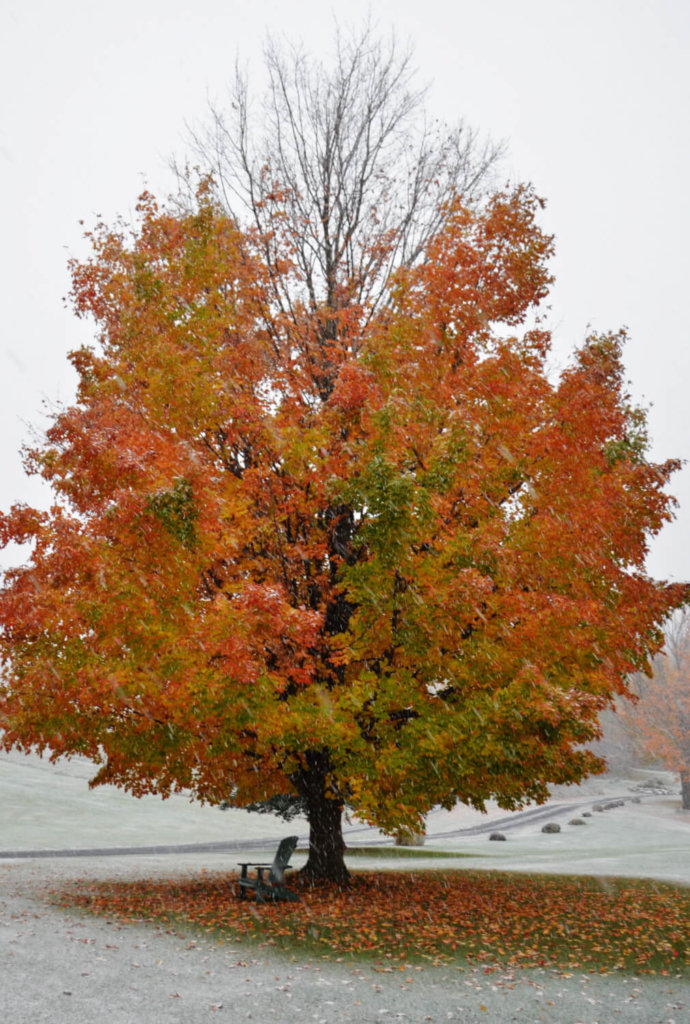Conservation Currents: Charlotte’s special trees

Following a legacy can be a challenge. Last year Charlotte lost two of its largest and most special trees—the slippery elm on Thompson’s Point Road and the butternut at Horsford’s—as well as another giant in town, our much-loved tree warden, Larry Hamilton, who died in early October. Larry was a professional forester and college professor, brimming with a contagious enthusiasm for people, for life and for trees in particular. At 91, he was about as sharp as he must have been at 60.
Twenty years ago Larry initiated a project that lives with us still: to create and maintain a list of the largest native tree species, those with the greatest girths, in the Town of Charlotte. Finding and identifying these trees took a great deal of time and interest on the part of Larry and his helpers, with enthusiasts coming forward with possible “winners.” As more “champions” of their kind were found, Larry took to adding their Abenaki names to the list of special trees along with the details of their size and type.
There’s a remarkable diversity to that list of 35 native species that Larry and friends created, including four different kinds of maple (black, sugar, red, silver), five different kinds of oaks (red, white, swamp white, burr, scarlet ) and several each of hickory, cedar, aspen, birch, ash, pine and elm.
Some of these giants have lived their lives and are now gone. Many of us have admired over the years the massive Slippery Elm that stood for well over 150 years in front of the Garretts’ house on Thompson’s Point Road, which expired in June, as did shortly thereafter the beloved butternut at Horsford’s Nursery. The black willow on Lewis Creek Road is long gone, according to its stewards at the Dinnan/Illick homestead. All these trees have a story, and many of them had a specific purpose in addition to adding shade and beauty.
The showy fragrant wood of the red cedar (Abenaki: Mekwisagezo) was used for over a century to make pencils because of its lightness and the ease with which it could be sharpened. White cedar (Koksk) was used by Jacques Cartier to cure his sailors of scurvy; Cartier learned this remedy from a Native American along the banks of the St. Lawrence River. The nut meat of the shagbark hickory (Bagimenakwam) was made into a protein-rich cream used in making hominy grits. Because of its lightness, basswood (Wigebimezi) was used for making crates, sandboxes, windowsills and sashes, and musical instruments and also for making excellent honey comb frames for hives. Every tree had its purpose.
With the demise of these trees from our woods, fields and yards, the list of special Charlotte trees still living has shrunk, and we would like to expand the list by identifying other stately trees in town. We cannot do this on our own, and therefore we are reaching out to you, our neighbors. Please let us know about other large or unusual trees in our neighborhoods. Tree observations are needed.
If you know of a special large, unusual or beautiful tree in town that you’d like us to know about, please call us. Do you have a particularly beautiful specimen on your land that you wish to highlight and tell us about? Perhaps you have the next champion of its kind on your property. Do you know of a giant tree that you’ve wondered about? Is your neighbor’s tree massive and you’ve always wondered how big it is?
It’s easy to find out. To measure the girth, take a string and wrap it around the tree at the height of 4.5 feet from the ground, being sure to keep the string level all the way around. When you have the dimensions, mark the string and then measure the string on a flat surface with a tape measure.
In the end, we’d like to tally new “giant trees” in town, as well as take note of particularly beautiful specimens. Once we identify the stateliest and most beautiful trees in Charlotte, we plan to create a photographic collection of these trees, from which we’ll produce a 2018 calendar of Charlotte’s biggest and most majestic trees for all of us to admire and learn from.
I had no idea there were so many different kinds of oaks in the Champlain Valley nor so many diverse types of trees. In discovering these trees and remembering that they’re all around us we can also honor the memory of Larry and his love of trees and all of nature.
We on the Conservation Commission are open to all new tree candidates! For more information contact Meg Berlin at (802) 425-5083 or by email.

